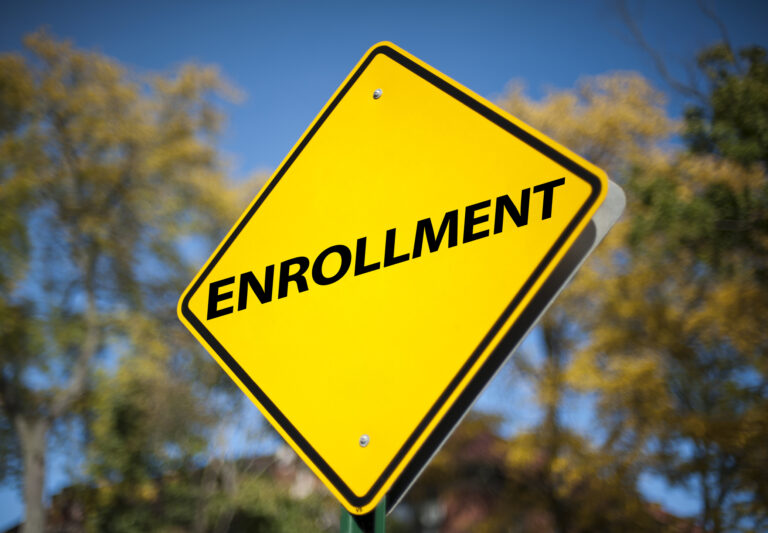Undergraduate enrollment increased across all institutional sectors this spring, with community colleges accounting for more than half of the increase, according to a new report. But officials are concerned that failure to implement the new FAFSA form and process could derail admissions momentum next fall.
According to the National Student Clearinghouse (NSC) Research Center, undergraduate enrollment increased 2.5% (359,000 students) this spring compared to last spring, led by a 4.7% increase (200,000 students) in community colleges, which accounted for 55.7% of the total increase, according to an analysis of spring data. After several years of declines in the spring semester, enrollment at primarily associate degree-granting baccalaureate institutions (PABs) turned a corner this spring, posting a strong increase (5.6%).
Growth rates also “took a step up” at community colleges, the sector hardest hit by the COVID-19 pandemic, Doug Shapiro, executive director of the NSC Research Center, said on a Zoom call with reporters on Tuesday. And among freshmen, too.
“The results are surprisingly good,” he said, estimating that despite concerns about the cost of higher education, students still appear to be pursuing university qualifications.
Associate degree enrollment continued to grow for the fall 2023 term, with 179,000 more students (4.4%) enrolled than for spring 2023. Enrollment in undergraduate certificate programs also continued to grow, while bachelor’s degree enrollment finally began to increase after four consecutive semesters of declines.
Despite the optimistic numbers, which community college leaders hope will continue to see increases this fall, Shapiro stressed that there is a long way to go to get out of the enrollment gap created by the decline in enrollment from the COVID pandemic, as noted in the Center’s previous report, which showed signs of enrollment recovery. Compared to spring 2020, overall undergraduate enrollment was down -6.0%, and community colleges were down -12.4%, according to the Center.
Shapiro said he was concerned that the federal FAFSA problem could discourage students from enrolling, especially those who are unsure about whether to attend college this fall. Students who have concrete plans for attending college this fall are more likely to “pass the FAFSA,” but those who are less sure “may already have other plans in place,” he said.
Data breakdown
A new report shows dual enrollment once again had a significant impact on undergraduate enrollment this spring. According to the report, the number of dual-enrolled high school students increased for the third consecutive year (10% or 101,000 students) and accounted for 28.1% of the increase in undergraduate enrollment. At community colleges, dual enrollment increased by 10.2%, or 69,126 students, this spring.
Growth in student enrollment varied by institution sector. Community colleges and PABs saw their first increases since 2020 (3.8% for community colleges and 4.8% for PABs), according to the Center. Public four-year institutions continued to see declines in enrollment of students ages 21 to 24.
Overall enrollment of first-time freshmen this spring also increased at 3.9%, with community colleges (6.2% or 14,000 students) and public PABs (11% or 5,000 students) making up two-thirds of spring enrollment, the center says.
Growing interest in career technology
Data shows continued strong interest in career and technical education (CTE) programs. According to the report, CTE-focused community colleges grew 17.6% this spring compared to last spring (117,000 students), and were actually 6.1% higher than pre-pandemic numbers (compared to spring 2020). (The number of students increased by 45,000).
Enrollment growth at transfer-focused community colleges was more modest, with transfer-focused universities increasing by 3.6% and transfer-focused mixed-educational institutions increasing by 1.2%, according to the report. That’s what it means.
Enrollment growth was seen across community college and PAB majors, with CTE-focused programs seeing the most growth. Mechanical Engineering and Repair Technology/Technicians (up 14.2% from last spring), Multidisciplinary/Interdisciplinary Studies (11.6%), Precision Manufacturing (10.2%), and Construction (8.1%).
Liberal Arts and Sciences remains the highest-enrolled program at public two-year colleges, with nearly 1.4 million students this spring, an increase of 0.8%. Health Professions and Related Clinical Sciences came in second with 658,685 students, a 4.4% increase. In third place was Business, Management, Marketing and Related Support, with 449,785 students enrolled this spring, a 3.0% increase from spring 2023.
PAB also experienced significant growth in many of the same sectors, with the main exceptions being social sciences, which saw an increase of 16.6%, construction (14.5%), and mechanics and repair technicians/technicians (12.4%). followed.

